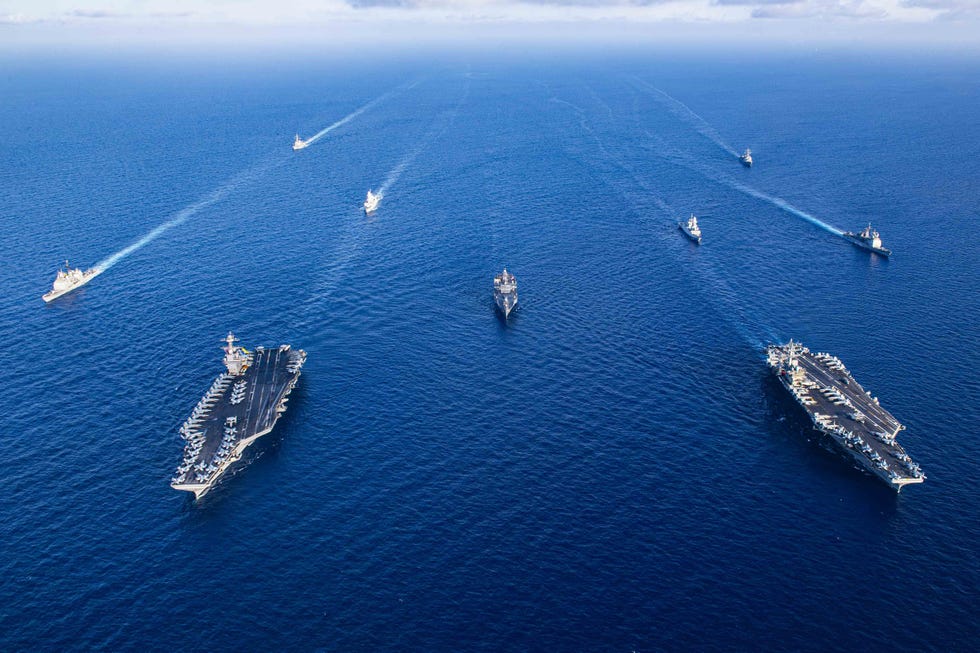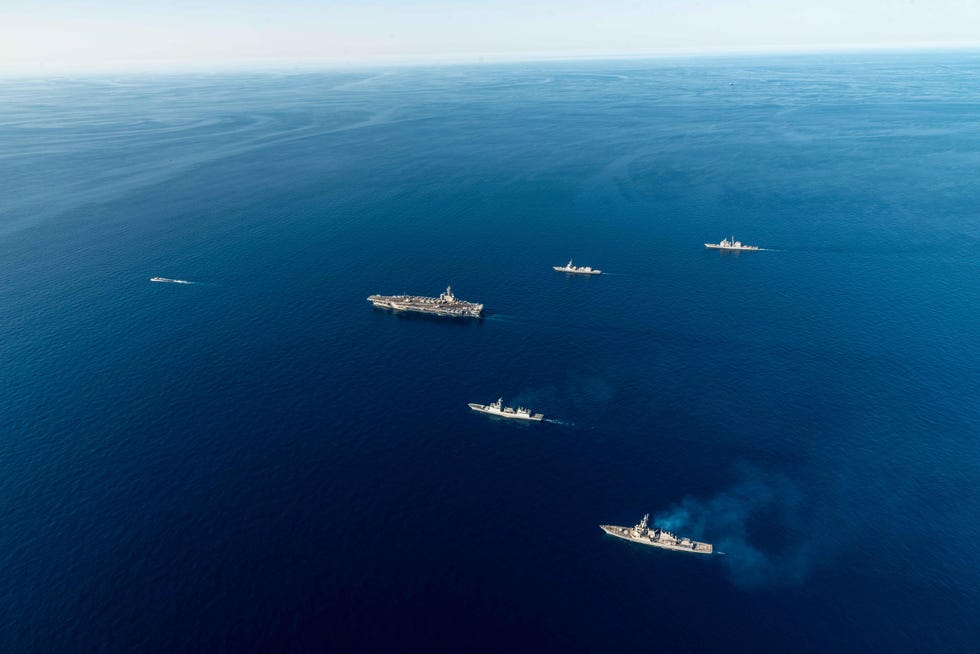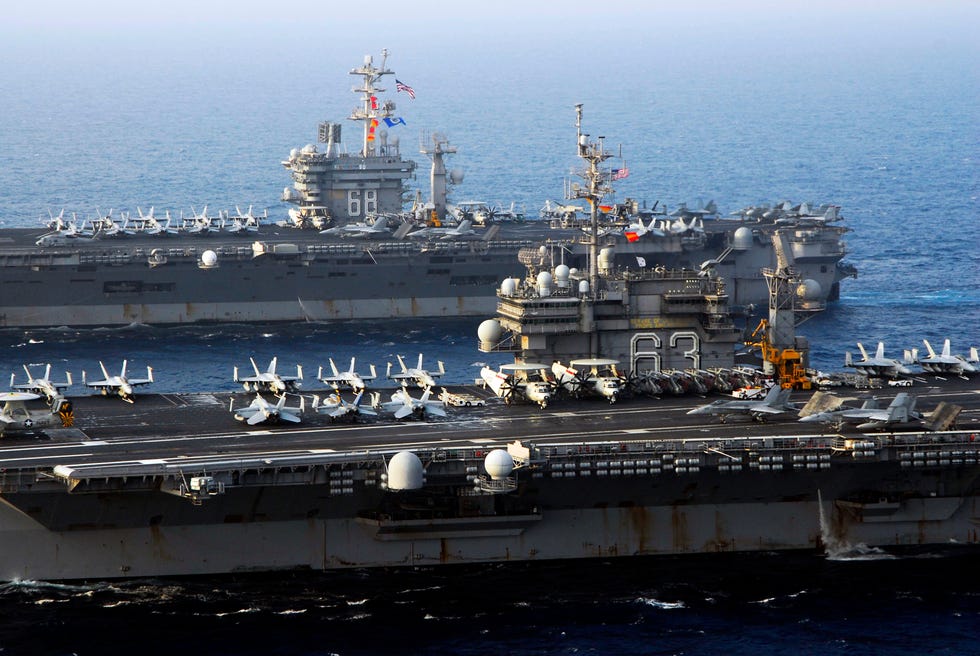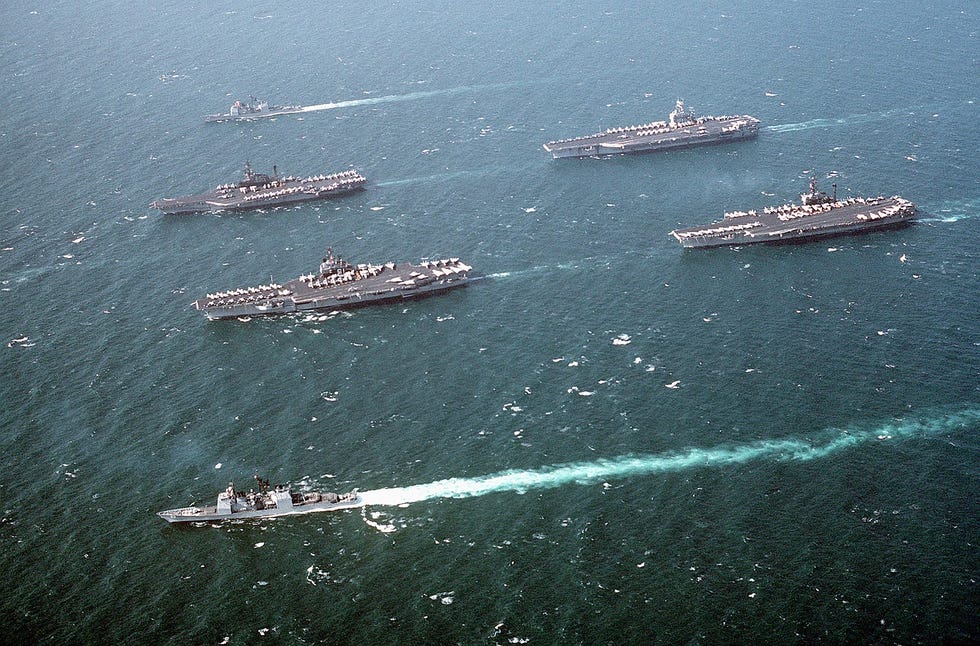KYLE MIZOKAMI

In the days after Hamas’s attack on Israel on October 7, the U.S. Navy did what it does best: sail an awe-inspiring amount of seapower to the doorstep of the latest crisis. The Navy placed not one but two carrier strike groups off the coast of Israel, along with accompanying cruisers, destroyers, and submarines.
Aircraft carriers have long served as a show of naval power, but in the era of modern warfare, it’s worth asking: how many aircraft carriers does the U.S. Navy actually need?
The Current Fleet
Let’s start by examining what we’re doing with the aircraft carriers we already have. Right now, the carriers Eisenhower, Ford, and Vinson are all on deployments, with Eisenhower in the Red Sea, Ford returning from an extended deployment in the Atlantic and the Mediterranean, and Vinson in the Philippines. The rest of the fleet are either coming off deployments or working up to them.

An aerial view of the aircraft carriers USS Gerald R. Ford and USS Dwight D. Eisenhower together in the eastern Mediterranean, on November 3, 2023.
The carrier USS Truman recently completed a Planned Incremental Availability period, a modest upgrade during which it gained the ability to operate the F-35C fighter. USS Bush is just entering a PIA.
USS Nimitz is in and out of Naval Base Kitsap in Washington, and may make one last deployment before retiring in 2025.
USS John C. Stennis is in the middle of a Reactor and Complex Overhaul, a lengthy period in which the ship is refurbished and the nuclear reactor takes on new fuel.

USS Reagan, homeported in Japan, frequently trains with South Korean and Japanese warships.
USS Reagan, based in Yokosuka, Japan, is back in port after a tour through the Philippine and South China seas. Reagan, the only U.S. carrier homeported overseas, tends towards shorter but more frequent deployments throughout the Asia-Pacific.
USS Theodore Roosevelt, USS George Washington, and USS Abraham Lincoln are the three carriers likely to deploy later this year. Reagan also might deploy this year, after two short deployments in 2023, though it will likely be restricted to the Pacific.
Out of 11 carriers, between three and four will be available to respond to crises in 2024. What if we wanted—or needed—more?
The One-Third Rule
Anyone reading this will probably realize that although the U.S. has 11 aircraft carriers, nowhere near 11 ships are on deployments. In most cases, the Navy can deploy three or four carriers at a time. Occasionally, such as in December 2022, the stars align, and the Navy may have five of eleven carriers underway at once.
The usual rule for deploying military units, from aircraft carriers to Army combat divisions, is that you need three to deploy one. Of the three, one is deployed, one is preparing to take its place, and one is just coming off deployment. This cycle allows a stage for units to prepare for deployment, training personnel and preparing hardware, a stage where the unit operates in the field at a combat-ready level, and a stage of rest and reconstitution.
In emergencies, this can be fudged a little bit: a unit scheduled to return can remain while its replacement arrives on station, giving commanders twice as many units as before. USS Ford, for example, was scheduled to return to Norfolk on October 17, 2023, but remained until January 1, 2024, due to the Gaza war. Although doable, this extends a typical six-month deployment and not only incurs additional wear on equipment, but more importantly sailors and their families.
Fifteen Flattops?
A quick, back-of-the-envelope analysis based on existing factors suggests 15 aircraft carriers—or the ability to have five underway at any one time—should do the trick.
The first factor is China—one of America’s biggest geopolitical adversaries. China poses an invasion risk to Taiwan, makes aggressive territorial claims in the South China Sea, and threatens allies including Japan. Three carriers in the Pacific at any one time, roughly one for every reason China is an adversary, would provide a credible deterrent. If Chinese planners had to contend with three American carrier strike groups pouncing on an invasion force headed to Taiwan, they might throw up their hands and declare the situation hopeless (for now, anyway). The same goes with any crisis in the South China Sea or involving our allies.

The aircraft carrier USS Kitty Hawk (front) and the nuclear-powered aircraft carrier USS Nimitz steam in formation during combined training exercises in the western Pacific Ocean, 2008.
The second factor is Europe and the Middle East. Russia, though bleeding military power in Ukraine, is still a major threat to NATO, especially for smaller states in the Baltics or in Scandinavia. The ability to project a carrier into the backyard of smaller allies can do a lot to calm local fears and upset the bad guys’ plans. Just like the Taiwan scenario, a great advantage of carriers is their mobility—the ability to suddenly enter a theater and upset an adversary’s carefully laid plans.
The U.S. military already has a fair number of air bases in friendly countries, so the need for aircraft carriers is not as great. Two carriers, responsible for the vast stretch of ocean between the Norwegian Sea and the Mediterranean, would be sufficient.
A U.S. Navy fielding 15 carriers could probably surge up to eight or nine carriers in an emergency.
How Do We Get There?

US Navy
In 1991, the U.S. Navy had 15 carriers, which allowed it to deploy four to Operation Desert Storm alone. Pictured is Battle Force Zulu, consisting of the carriers USS Midway, Ranger, Theodore Roosevelt, and America.
There are two ways to get from 11 to 15 aircraft carriers. The most obvious is to build more carriers, increasing the number under construction at any time from one to two. Another is to retain older ships longer than anticipated: for example, USS Nimitz, scheduled to retire in 2025, might stick around until 2032.
It’s important not to forget that a carrier is just one part of a carrier strike group. A carrier might cost $11 billion, but the planes that equip it could cost another $5 billion. At least three destroyers, at about $2 billion apiece, would be needed to bodyguard the ship. Each carrier strike group is also assigned a submarine, which would cost about $4 billion. Munitions for all the ships, subs, and aircraft would cost about another billion.
All in all, each new carrier strike group would cost about $27 billion, or $108 billion for four. Finally, each strike group would add about 7,000 personnel to the size of the Navy, and decades after the ships are decommissioned and turned into steak knives, the Navy will still be paying benefits to the retirees.
No comments:
Post a Comment